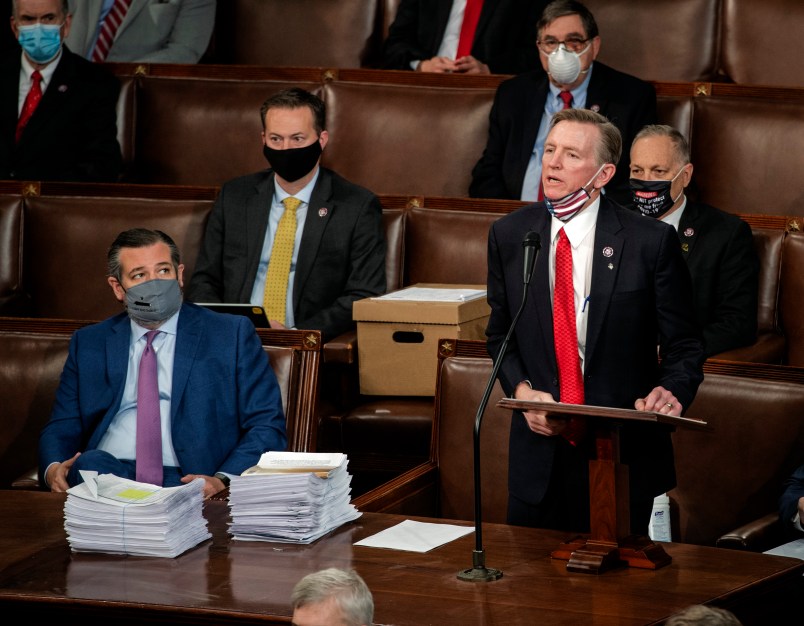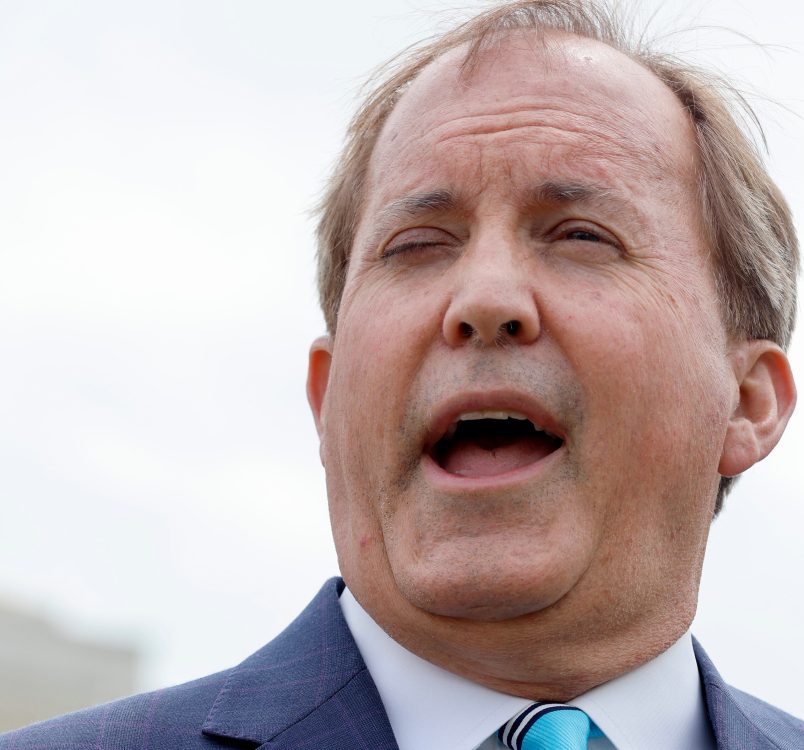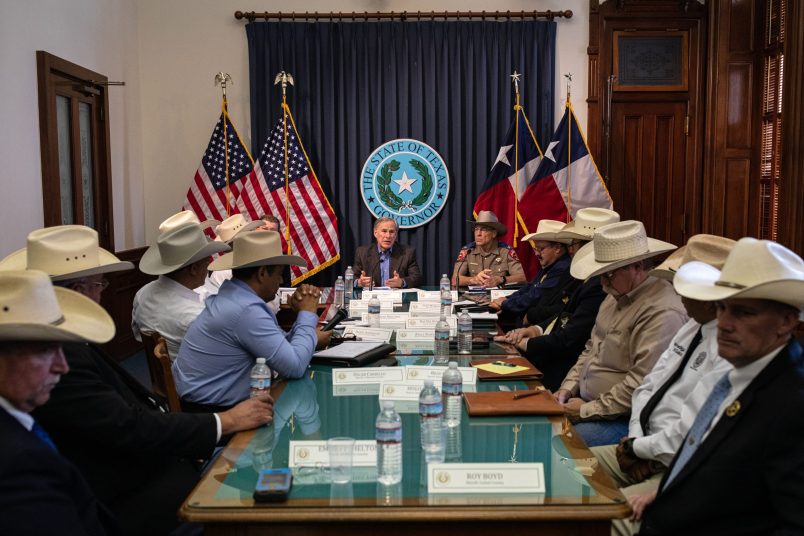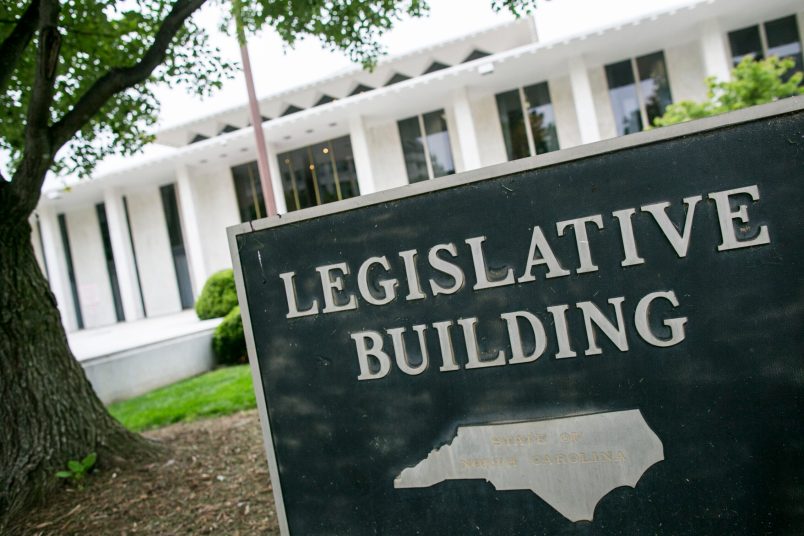Rep. Zoe Lofgren (D-CA) has published an absolutely massive report compiling the social media posts of every Republican who voted to object to the counting of certain states’ Electoral College votes on Jan. 6.
Then-President Donald Trump had hyped that Jan. 6 congressional objection effort as his last real hope of stealing a second term, and on the morning of Jan. 6, he urged the thousands of supporters that he’d summoned to Washington, D.C. to march on the Capitol and provide some “courage” to the members of Congress voting inside.
Many of those members spent weeks spreading what Democrats have begun calling the “big lie” — the false claim that the 2020 election was fraudulent, and that Joe Biden was not the rightfully elected president. Lofgren’s report, documenting over 1,900 pages of tweets, creates a detailed record of the effort to justify overturning an election. Here are some takeaways:
A handful of reps made a ton of noise.
The Lofgren review of social media posts — it’s more like a PDF database, organized alphabetically by member — makes one thing clear: A small handful of congressmen and women made much of the social media noise from November through January.
Rep. Paul Gosar (R-AZ) appears to have been the most prolific. The Trump die-hard, who recently spoke at a political conference organized by the white nationalist Nicholas Fuentes, takes up a full 176 pages of the 1,900 page report. Reps. Mo Brooks (R-AL), Matt Gaetz (R-FL) and Billy Long (R-MO) aren’t far behind, taking up around 120 pages each. Rep. Majorie Taylor Greene’s (R-GA) tweets take up 94 pages.
The posts from these loyalists offer a real-time view of the Trumpian strategy. Brooks, for example, shifts over time from complaints about “en masse” mail-in voting, to his own dubious claims about voting machines, to assertions about votes from an “illegal alien block” and people other than “eligible American citizens.” On the morning of Jan. 6, Brooks said from the rally stage in front of the White House that patriots ought to start “taking down names and kicking ass.” But in the middle of the attack, he’d already begun shifting blame for the riot: “Rumor: ANTIFA fascists in backwards MAGA hats” he tweeted at 2:20 p.m., the start of a lie that persists today.
GOP leadership tried to lend credibility to Trump’s BS with “reasonable” demands for “transparency” and counting “legal votes.”
All but one member of GOP House leadership (Republican Conference Chair Liz Cheney from Wyoming) voted to overturn the election: House Minority Leader Kevin McCarthy (R-CA), House Minority Whip Steve Scalise (R-LA) and Republican Policy Committee Chair Gary Palmer (R-AL).
Lofgren’s compilation included a McCarthy tweet that promoted a clip of his Fox Business interview on November 4, when Joe Biden was beginning to emerge as the winner. McCarthy declares in the clip: “We’re going to have to fight because we want to make sure every legal vote is counted.”
That soundbite — ”every legal vote needs to be counted” — and demands for “transparency” became the codewords employed by the House minority leader and Scalise in their attempts to legitimize Trump’s lies about election fraud. Their language indicates how they were careful not to lean too much into Trump’s more outlandish claims; they never explicitly accuse Democrats of stealing the presidential election (though McCarthy did accuse them of trying to steal the razor-thin race in Iowa’s 2nd Congressional District). Rather, their tweets show them trying to chip away at the legitimacy of the election in more subtle ways, by raising supposedly “serious” questions “about election integrity” and baseless claims that “millions” of ballots are “ripe for voter fraud.”
(Lofgren’s compilation did not include posts from Palmer. The methodology notes that a lawmaker may not be listed if they didn’t post relevant content in the study’s set time frame.)
Weeks of fighting words presaged the deadly attack.
For weeks after Election Day, Republicans following Donald Trump’s lead amped up the rhetoric as his options for a legal victory dwindled. As the vote-counting continued and the reality of Biden’s lead became clear, the violent rhetoric only grew.
On Nov. 6, for example, Gaetz tweeted “I’ll fight on the floor of the House of Representatives to stop the Electoral College from being certified.”
Gosar quote-tweeted him and commented, “Where do I sign up?”
Rep. Marjorie Taylor Greene frequently tweeted about the need to “fight” the election results. On Dec. 19, when Trump first announced a “wild” protest in Washington, D.C. for Jan. 6, Greene tweeted “I’m planning a little something on January 6th as well, @realDonaldTrump.” She tweeted the #FightForTrump hashtag the following day, before boosting details of the Jan. 6 protest as it came together. “I need a massive grassroots army behind me to STOP THE STEAL,” she wrote a week before the rally. The day prior to the rally, she referred to “OUR 1776 MOMENT” in an interview with Newsmax.
Even on clean-up duty after weeks of false and inflammatory claims, some Republicans used the prospect of violence as a lever: Brooks, on Jan. 7, wrote that when citizens lose faith in the system, they have “three bad options”: Emigrating, submitting, or fighting back with violence. “We don’t ever want citizens in America feeling they have been forced into the aforesaid box, with 3 bad options,” he wrote.
The right-wing media disinformation machine was a key weapon.
The conservative media’s role in amplifying Trump’s bogus claims about the election has already been well-established.
However, this study highlighted the extent to which the ex-president’s foot soldiers in the House used pro-Trump outlets like Fox and Newsmax as a bullhorn in their crusade to overturn the election and then to do damage control as they tried to shift blame away from themselves and Trump for the insurrection. When they weren’t posting clips of themselves ranting to Lou Dobbs and other sympathetic pro-Trump media cranks, they were sharing bogus articles from fringe websites like the Epoch Times or Town Hall to boost their false claims.
One example of this was when Gaetz and Greene shared a Washington Times article that falsely claimed that facial recognition technology found that members of antifa were part of the mob that stormed the Capitol. The Times was forced to issue a correction after the tech company stated that their article was “outright false” and that their software had actually caught two neo-Nazis, with no evidence of antifa being present.
The document itself is an important step toward accountability.
The existence of the mammoth document is notable in the first place, and marks a major step from Lofgren in creating a social media record for any investigations that may be coming down the pike. On her website, the congresswoman noted that she participated, either as a staffer or as a member of Congress, in all four modern presidential impeachment hearings, in addition to congressional removal proceedings for other government officials including former federal Judge G. Thomas Porteous, Jr. and former Rep. James Traficant. Lofgren is today the chair of the Committee on House Administration.
In light of that experience, Lofgren wrote, colleagues have asked her for guidance on what can be done about other members’ of Congress “involvement in the January 6th attempt to overthrow the lawful government of the United States.” Lofgren cited some potential avenues of accountability, including expulsion from Congress for violating the 14th Amendment’s provisions related to insurrection, congressional punishment for disorderly behavior and even potential criminal investigation.
Disciplinary action, the congresswoman wrote, “is a matter not only of the Constitution and law, but also of fact.” To establish those facts, Lofgren said, she asked her staff to take a “quick look” at social media posts from members who voted to overturn the 2020 presidential election. The 1,900-page document is an attempt to compile statements that may be part of Congress’ future responsibilities.






